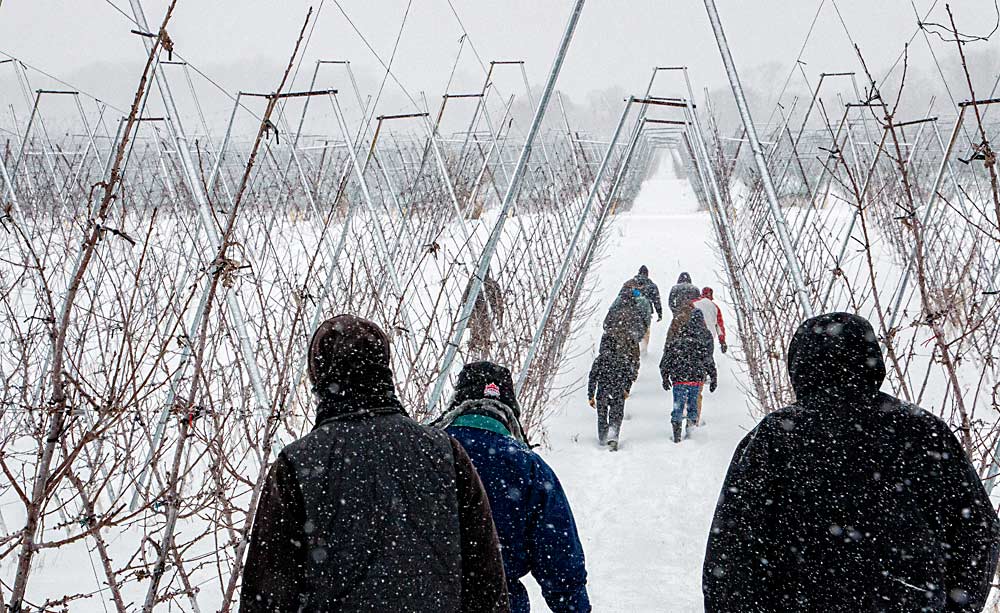
The International Fruit Tree Association returned to the place of its founding, Michigan, for its 63rd annual conference.
Three of Michigan’s major fruit-growing areas lie in the greater Grand Rapids region: Belding, Fremont and the Ridge — the latter, marked by rolling hills of loamy clay soil that stretch 22 miles north of Grand Rapids and 8 miles wide, is home to the bulk of Michigan’s apple production. There are more than 22,000 acres of apples in the region, and 80 percent of the state’s fresh apples are sold through its sales desks, according to Amy Irish-Brown and Phil Schwallier, Michigan State University Extension educators who serve growers on the Ridge.
Those sales desks have been consolidating in the past year or two in an effort to keep up with consolidation among retail customers. Like other fruit-producing regions, Michigan is trying to stay abreast of an ever-shifting global marketplace — and its growers are adopting ever-more precise and innovative growing systems to keep their competitive edge.
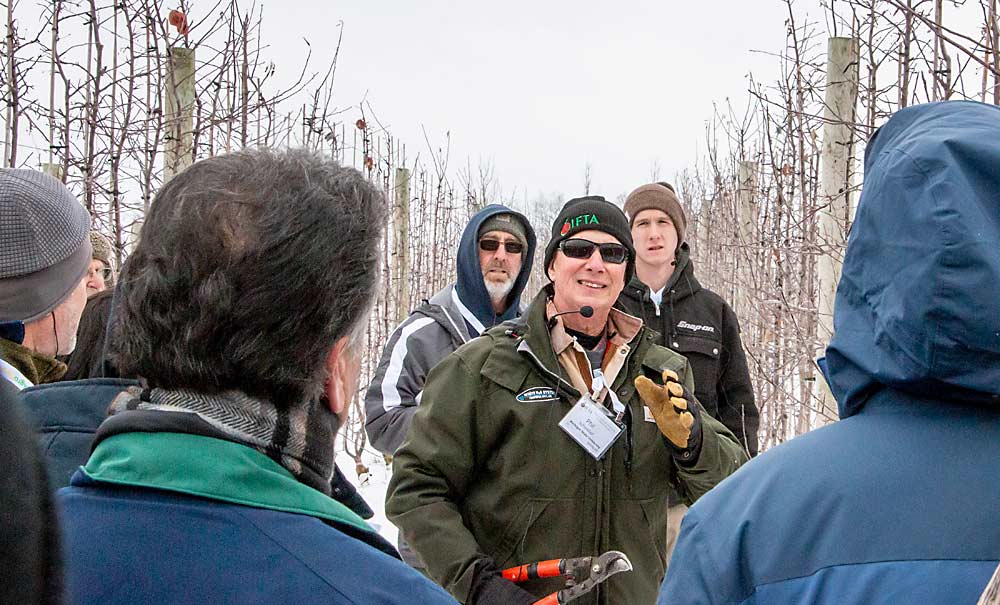
As part of the IFTA conference dubbed “Precision Vision 2020” in Grand Rapids in late February, which included speakers who highlighted precision canopy and orchard management, Schwallier and Irish-Brown organized a tour to showcase growers who’ve adopted innovative growing systems and who’ve been improving their management practices to make them more precise.
“We chose tour stops that would give (IFTA) members a view to the new and cutting-edge technologies that fit with our conference theme,” Schwallier said.
The tour included a stop at MSU’s Clarksville Research Center, located about halfway between Grand Rapids and MSU’s main campus in East Lansing, where multiple research trials vital to the future of Michigan’s growers are underway.
Among them: a multileader training trial for apples, led by Schwallier and funded by the Michigan Tree Fruit Commission. The trial, planted in 2015, includes five varieties on four systems: super spindle, two-leader, three-leader and tall spindle, all on Nic.29 rootstock. All of the systems produced high-quality apples with exceptional red color. The most productive system so far, in terms of bins per acre, is super spindle.
“Right now, I favor super spindle, but I like tall spindle, too,” Schwallier said. He wants to follow the trials for another three years before making a final determination.
The most productive variety in the trial in 2019 was Gala, at an average of 27.5 bins per acre, followed by Fuji (20.4), Jonagold (15.1), McIntosh (11.8), and Honeycrisp (6). The high-vigor varieties filled space rapidly and settled into fruiting quickly. Honeycrisp lagged behind other varieties in terms of filling space. In 2019, McIntosh was overthinned and did not perform as well as it did in 2018, he said.
Schwallier said multileader systems require a bigger investment of time and money on the grower’s part, but the higher yields make up for it in the long run.
After Clarksville, the tour headed northwest to the Ridge, to see innovative systems in commercial orchards.
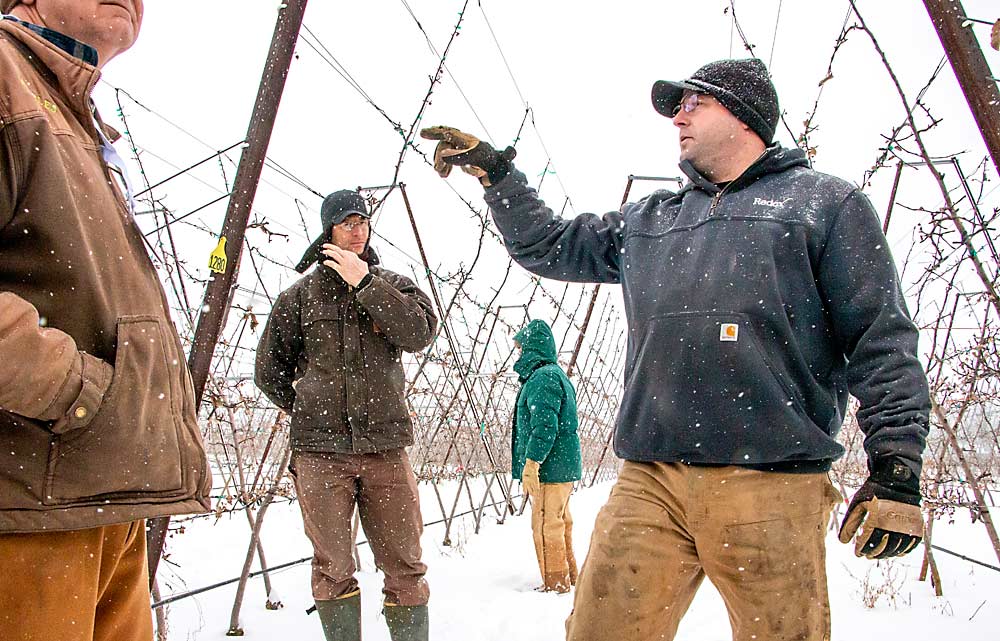
At a Riveridge Land Co. orchard in Grant, IFTA visitors got to see an unusual sight for Michigan: V-trellis. Operations Manager Justin Finkler said the 24-acre block of Royal Red Honeycrisp was planted 12-by-2 on Nic.29 rootstock in 2014.
Several years ago, Riveridge was seeking a growing and training system that would, Finkler said, “allow us to compete with the most advanced growers in the business” — a high-yielding system that would lend itself to mechanization. After visiting orchards in the Western U.S., Riveridge management decided the V system was what they were looking for, he said.
Terence Robinson, a professor and fruit crop physiologist with Cornell University, has been preaching the benefits of V-shaped canopies for three decades. During a conference presentation, he reminded the IFTA audience that V systems intercept more light and have higher yields, although fruit color on the underside of the V can be poor (a problem that can be solved by placing reflective film underneath). Despite the benefits, however, the V system hasn’t been widely adopted in the Eastern United States.
Because the V system isn’t common in Michigan, Riveridge has faced a steep learning curve. But there’s a lot to like so far. Finkler appreciates the system’s uniformity. It makes precision tasks — counting buds, limbs and fruit, for example — easier. New employees quickly master it. And platforms can be used every step of the way, he said.
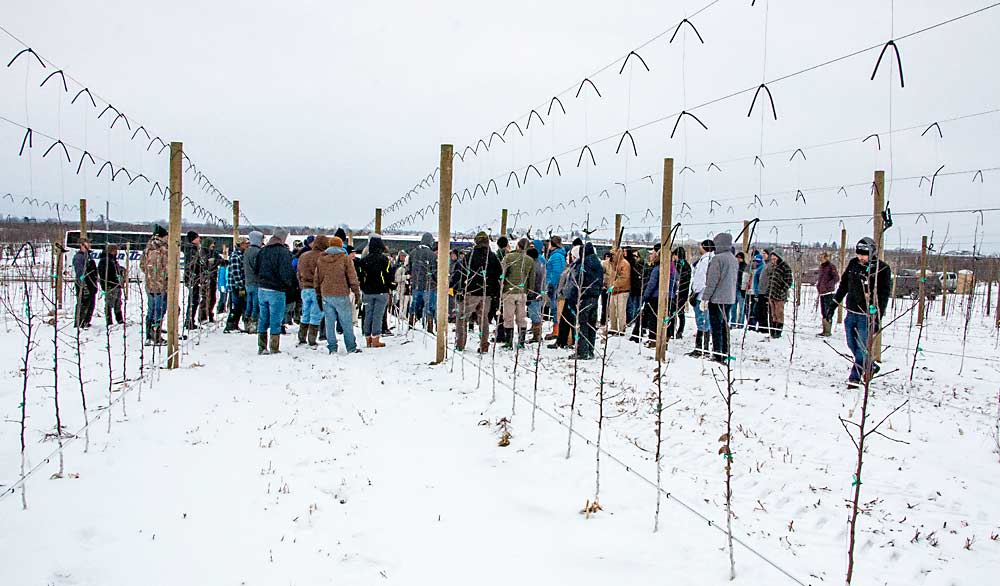
Riveridge now has 260 acres of apples planted on V-trellis, including Ambrosia and EverCrisp on Geneva 41. Since the first planting, they’ve been “beefing up” the trellis system — putting more stakes in the ground, steepening the angle, adding more bracing, tightening the wires, strengthening the anchors — and planting more trees per acre, with later plantings at more than 3,600 trees per acre. The initial investment is big, but the company plans to continue with the V system in the belief it can help them reach their yield and quality goals, Finkler said.
“I don’t think we’ll plant another apple that’s not a V,” he said.
At Joe Rasch Orchards in Conklin, the IFTA tour saw a popular apple variety on a popular system: Premier Honeycrisp on tall spindle. The block was planted on Budagovsky 10 rootstock in spring 2019.
In order to make the block cheaper and more efficient to manage, they use rubber ties to tie the trees to the trellis, attaching them to 14-gauge wire that is strung, via staples, from post to post. They used to tie the trees to bamboo, but bamboo has a tendency to rot, so they tie the trees to additional vertical wire, which is cheaper and faster to set up, said Manuel Vargas, one of the farm’s managers.
“We’re trying to keep costs down on the trellis without under-trellising,” owner Joe Rasch said.
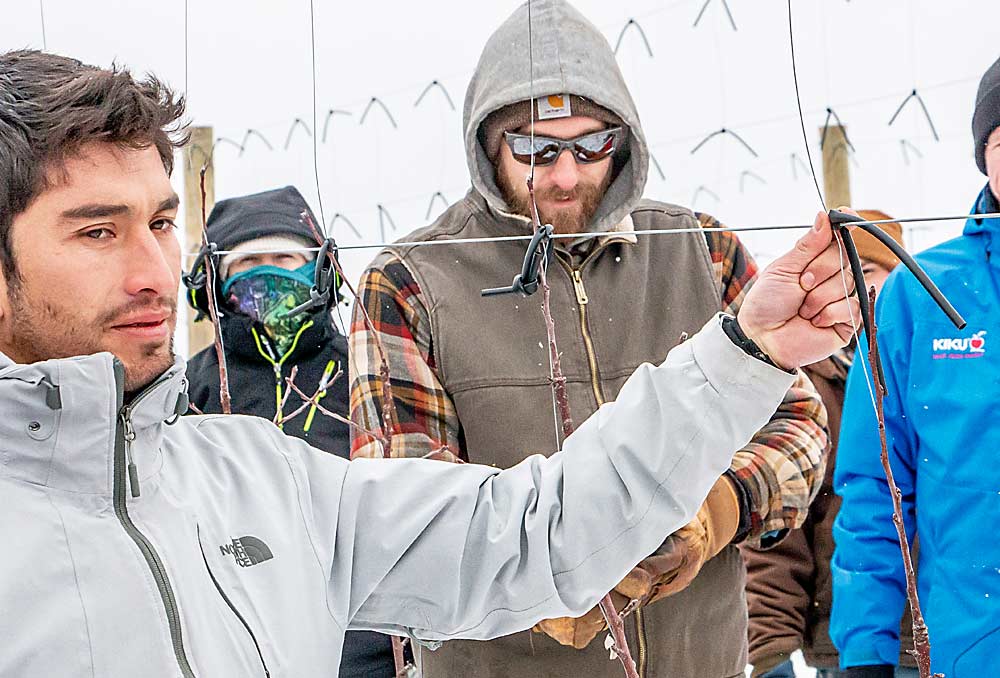
While they use vertical wire in the Honeycrisp block, they don’t need vertical wire in a nearby block of Ambrosia on G.935, because it’s a very strong tree that grows quickly. For that block, they just tie the trees to the horizontal wire, Vargas said.
“We think they’ll make the top wire fine,” Rasch said. “Some of them are nearly there in the first year.”
At Ridgeview Orchards, co-owner Dan Dietrich showed the IFTA audience a 10-acre block of grafted, double-leader trees. The existing block was grafted over in 2014 and now consists of Fuji, Gala and Honeycrisp on Malling 9 and Nic.29.
In Dietrich’s opinion, grafting is cheaper, and a little bit faster, than completely replanting trees. The disadvantage is that you’re stuck with your existing rootstock and row spacing — less precise than a new planting, perhaps, but if you’re already happy with your rootstock and spacing then grafting is a great option.
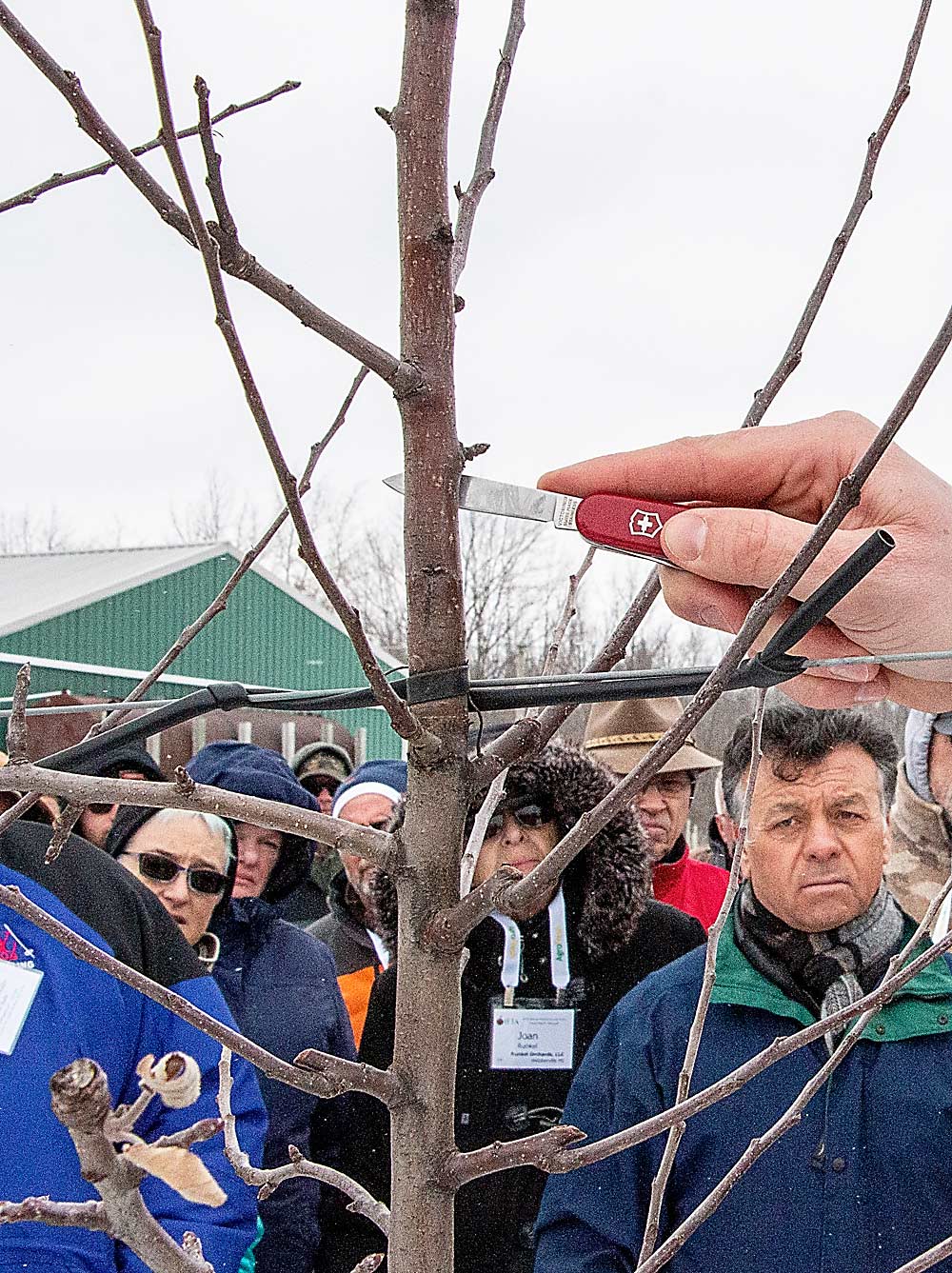
“Grafted trees grow better,” he said. “There’s already a root underneath them. The tree wants to replace what it lost fast.”
In fact, grafted trees can be so vigorous in the first two or three years that their growth is almost “out of control,” he said.
“Strong trees don’t like to set fruit,” Dietrich said. “Until the tree calms down, you don’t always get a nice apple.”
Cherries and peaches, too
Riveridge Land Co., which gave IFTA visitors a look at apples on a V-trellis at its orchards in Grant, Michigan, also displayed a 20-acre block of sweet cherries — Benton and Skeena on Gisela 5 rootstock — in a V system, planted in partnership with Greg Lang, a Michigan State University professor who studies sweet cherry systems.
Riveridge decided to “jump all the way in” with V sweet cherries a few years ago, Lang said. They’ve been happy with their cherry yields so far, but they’ll have to keep an eye out for overcropping as the trees approach their fourth and fifth leaf and start to lose their vegetative vigor.
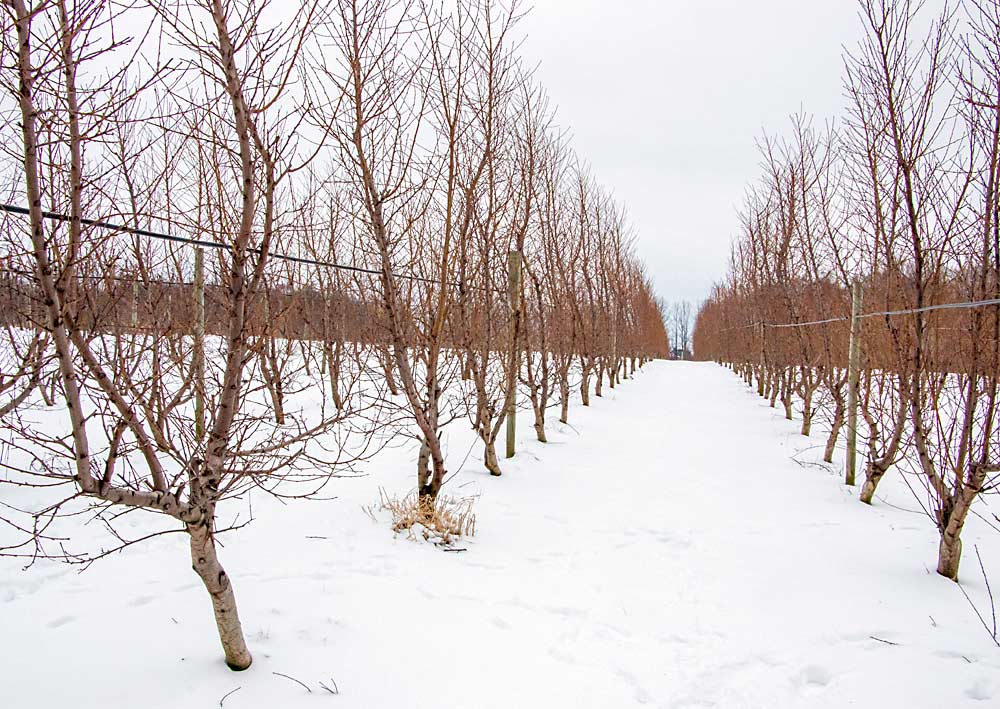
At Windy Ridge Orchards in Conklin, the tour saw another unusual sight for Michigan: UFO peaches. Owner Chuck Rasch has been growing peaches since 1985 and currently has 5 acres. Two of those acres are planted in a V system, the rest on the UFO (upright fruiting offshoots) system.
Rasch decided to try UFO in 2015, after seeing a trial at MSU’s Clarksville Research Center. UFO is not a common system for peach trees, which lack dwarfing rootstocks, but Rasch likes the system because it works with the peach tree’s tendency for upright growth while at the same time slowing down its vigor with multiple leaders.
Rasch’s 3-acre UFO block consists of the Starfire, EarliGlo, Allstar and Glowing Star varieties, all planted on Bailey rootstock. So far, the trees are fruiting well, yielding about 440 bushels per acre. He’s not sure he would recommend UFO to other peach growers in the area yet — he wants to see how they’re doing five years from now — but he plans to plant another 4 acres this spring. •
—by Matt Milkovich
Related:
—Still no answer for bitter pit
—Growing from there to here






Leave A Comment